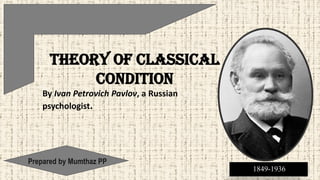
Classical conditioning
- 1. THEORY OF CLASSICAL CONDITION By Ivan Petrovich Pavlov, a Russian psychologist. Prepared by Mumthaz PP 1849-1936
- 2. It was called by the name of classical because it was the first to be reported in the psychological report. He was the first to perform experiments to study how stimuli and responses associated. He conducted a number of experiments to study the connection between stimulus and responses. Theory of classical conditioning considers learning has habit formation.
- 3. EXPERIMENT Pavlov conducted a number of experiments in dog to study how the stimulus and responses are associated by simple surgical operations, a flow of saliva from a dog’s mouth, was transfered to a glass tube at the sight of food, the dog salivated then immediately before giving food to the dog, a bell was rung. This experiment was repeated for several days. After many days come the bell only but did not give any food to the dog, still the dog secreated saliva in the same quantity as before.
- 5. Salivation at the sound of the bell is an acquired response and this acquired response is called as conditioned response(CR). The process of strengthening a conditioned response through reinforcement is called conditioning. OUTPUT
- 6. BASIC ELEMENTS OF CLASSICAL CONDITIONING
- 7. UNCONDITIONED STIMULUS (US) Something that automatically causes a response(naturalistic).
- 8. UNCONDITIONED RESPONSE (UR) Automatic reaction to a response.
- 9. CONDITIONED STIMULUS (CS) Stimulus to which a subject learns to respond through repeated pairings with an unconditioned stimulus.
- 10. CONDITIONED RESPONSE (CR) Learned response to a conditioned stimulus.
- 11. EXTINGUISHED BEHAVIOR Faiding of learned behavior due to the lack of reinforcement.
- 12. SPONTANIOUS RECOVERY Reappearance of extinguished behavior without any provocation.
- 13. PROCESS OF CONDITIONING Before conditioning Before conditioning During Conditioning After conditioningUS (food) UR (saliva) NS (neutral stimulus (bell) ) no salivation CS (bell) + US (food) salivation CS (bell) (salivation) CR
- 16. PRINCIPLE OF REINFORCEMENT According to Pavlov it was only the reinforcement that lead to conditioning. In classical conditioning US (food) is stated as a reinforce.
- 17. PRINCIPLE OF TIME INTERWAL There is an optimal time between the presentation of the CS and US. Conditioning is slower if pairing follows each other to quickly or too far apart.
- 18. PRINCIPLE OF EXTINCTION The strength of CR gradually decreases to no response at all if the CS is always repeated alone. If the sound of the bell is not followed by food, the dog stops to secreate saliva.
- 19. The reappearance of an extinguished behavior is called spontaneous recovery. Spontaneous recovery occurs when a response reappears without any retraining after having been extinguished. PRINCIPLE OF SPONTANEUOS RECOVERY
- 20. PRINCIPLE OF STIMULUS GENERALSATION Reaction to similar stimuli is called stimulus generalization. Conditioned responses are elicited not only by the conditioned stimulus but also by similar stimuli.
- 21. PRINCIPLE OF STIMULUS DESCRIMINATION It occurs when subject learned to respond only to certain stimulus but not to other stimuli. This is done by regularly reinforcing stimulus and non reinforcing the other.
- 22. PRINCIPLE OF HIGHER ORDER CONDITIONING When conditioning is done to a new stimulus on the basis of a previously conditioned stimulus, it is designated as higher order conditioning.
- 23. PRINCIPLE OF PRIMARY AND SECONDARY REINFORCEMENT It is used to denote the stimulus connected with the organisms basic psychological need systems. For example food. In secondary reinforcement, stimulus regularly associated with primary reinforce aqquire the power to strengthen behavior.
- 24. PRINCIPLE OF INHIBITION There are two types of inhibitions external inhibition and internal inhibition. External inhibition: onece the dog was conditioned but it was found not to give conditioned response in the presence of strangers. Internal inhibition: physical health of the organism may block the response.
- 26. The principle of classical conditioning can be used for developing good habit of children such as cleanliness and punctuality.
- 27. It can be used for deconditioning or breaking of anxiety, fear and fobias.
- 28. It can be used to develop positive attitude towards.
- 29. The theory emphasizes the important of reinforcement in learning.
- 30. THANK YOU MUMTHAZ PP STUDENT KEYI SAHIB TRAINING COLLEGE